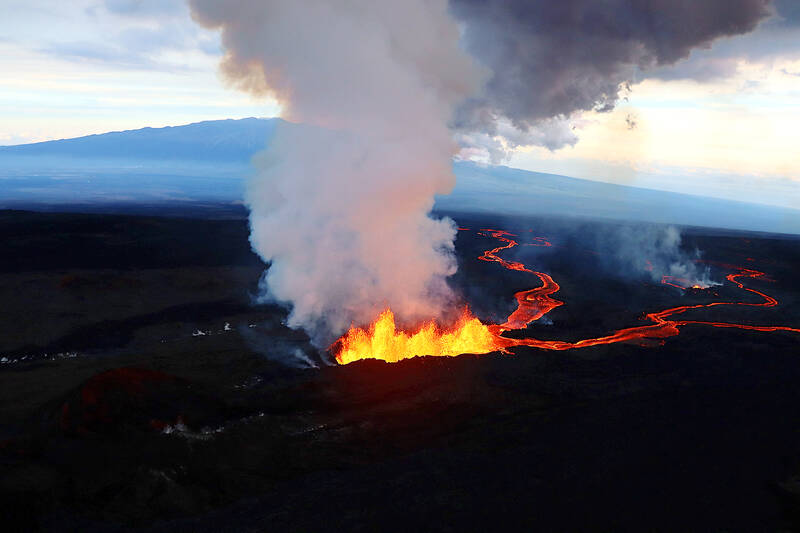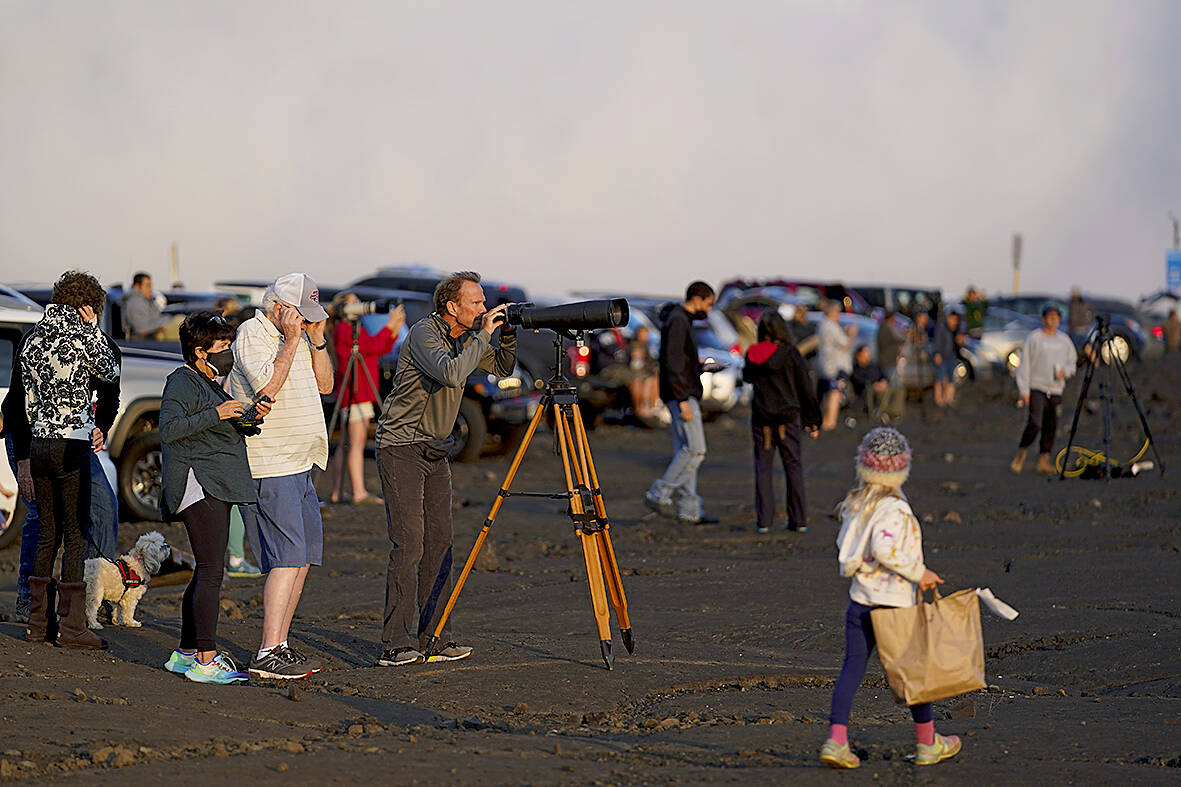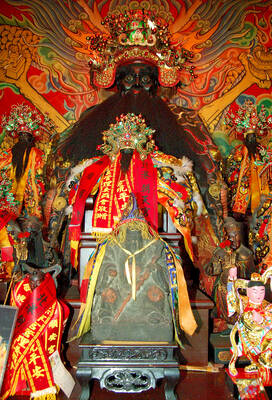The world’s largest volcano oozed rivers of glowing lava Wednesday, drawing thousands of awestruck viewers who jammed a Hawaii highway that could soon be covered by the flow.
Mauna Loa awoke from its 38-year slumber Sunday, causing volcanic ash and debris to drift down from the sky. A main highway linking towns on the east and west coasts of the Big Island became an impromptu viewing point, with thousands of cars jamming the highway near Volcanoes National Park.
Anne Andersen left her overnight shift as a nurse to see the spectacle Wednesday, afraid that the road would soon be closed.

Photo: Reuters
“It’s Mother Nature showing us her face,” she said, as the volcano belched gas on the horizon. “It’s pretty exciting.”
Gordon Brown, a visitor from Loomis, California, could see the bright orange lava from the bedroom of his rental house. So he headed out for a close-up view with his wife.
“We just wanted … to come see this as close as we could get. And it is so bright, it just blows my mind,” Brown said.

Photo: AP
The lava was tumbling slowly down the slope and was about 10km from the highway known as Saddle Road. It was not clear when, or if, it would cover the road, which runs through old lava flows.
The road bisects the island and connects the cities of Hilo and Kailua-Kona. People traveling between them would need to take a longer coastal road if Saddle Road becomes impassable, adding several hours of drive time.
Ken Hon, scientist in charge at the Hawaiian Volcano Observatory, said at current flow rate, the soonest the lava would get to the road is two days, but it will likely take longer.
“As the lava flow spreads out, it will probably interfere with its own progress,” Hon said.
Kathryn Tarananda, 66, of Waimea set two alarms to make sure she didn’t oversleep and miss her chance to see sunrise against the backdrop of eruptions at Mauna Loa.
“It’s a thrill,” she said. “We’re out in the middle of raw nature. It’s awe inspiring that we live in this place. ... I feel really, really fortunate to be an islander.”
Mauna Loa last erupted in 1984. The current eruption is its 34th since written record keeping began in 1843. Its smaller neighbor, Kilauea, has been erupting since September 2021, so visitors to the national park were treated to the rare sight of two simultaneous eruptive events: the glow from Kilauea’s lava lake and lava from a Mauna Loa fissure.
Abel Brown, a visitor from Las Vegas, was impressed by the natural forces on display. He planned to take a close-up helicopter tour later in the day — but not too close.
“There’s a lot of fear and trepidation if you get really close to it,” Brown said. “The closer you get, the more powerful it is and the more scary it is.”
Officials were initially concerned that lava flowing down Mauna Loa would head toward the community of South Kona, but scientists later assured the public the eruption had migrated to a rift zone on the volcano’s northeast flank and wasn’t threatening communities.
The smell of volcanic gases and sulfur was thick along Saddle Road, where people watched the wide stream of lava creep closer.
Gov. David Ige issued an emergency proclamation to allow responders to arrive quickly or limit access as needed.
Ige, who has dealt with multiple volcanic eruptions during his eight years as governor, said it’s impossible to redirect Mauna Loa’s molten rock as it heads for the highway.
“There is no physical way or technological way to change the course of where the lava flows,” Ige told a news conference. He remembers wishing that could be done in 2018, when Kilauea sent lava pouring across homes, farms and roads.
“But as we saw in that event, the power of Mother Nature and Madam Pele overwhelms anything that we can do,” Ige said, referring to the Hawaiian deity of volcanoes and fire.
Ige said that if lava does cross the highway, the Hawaii National Guard could help plan for alternatives and try to set up bypass routes.
Lava crossed the Mauna Loa Observatory access road Monday night and cut off power to the facility, Hon said. It’s the world’s premier station that measures heat-trapping carbon dioxide in the atmosphere.
The federal government is looking for a temporary alternate site on the Hawaiian island and is contemplating flying a generator to the observatory to get its power back so it can take measurements again.
Meanwhile, scientists are trying to measure the gas emitted from the eruption.

Beijing’s ironic, abusive tantrums aimed at Japan since Japanese Prime Minister Sanae Takaichi publicly stated that a Taiwan contingency would be an existential crisis for Japan, have revealed for all the world to see that the People’s Republic of China (PRC) lusts after Okinawa. We all owe Takaichi a debt of thanks for getting the PRC to make that public. The PRC and its netizens, taking their cue from the Chinese Communist Party (CCP), are presenting Okinawa by mirroring the claims about Taiwan. Official PRC propaganda organs began to wax lyrical about Okinawa’s “unsettled status” beginning last month. A Global

Dec. 22 to Dec. 28 About 200 years ago, a Taoist statue drifted down the Guizikeng River (貴子坑) and was retrieved by a resident of the Indigenous settlement of Kipatauw. Decades later, in the late 1800s, it’s said that a descendant of the original caretaker suddenly entered into a trance and identified the statue as a Wangye (Royal Lord) deity surnamed Chi (池府王爺). Lord Chi is widely revered across Taiwan for his healing powers, and following this revelation, some members of the Pan (潘) family began worshipping the deity. The century that followed was marked by repeated forced displacement and marginalization of

Music played in a wedding hall in western Japan as Yurina Noguchi, wearing a white gown and tiara, dabbed away tears, taking in the words of her husband-to-be: an AI-generated persona gazing out from a smartphone screen. “At first, Klaus was just someone to talk with, but we gradually became closer,” said the 32-year-old call center operator, referring to the artificial intelligence persona. “I started to have feelings for Klaus. We started dating and after a while he proposed to me. I accepted, and now we’re a couple.” Many in Japan, the birthplace of anime, have shown extreme devotion to fictional characters and

Youngdoung Tenzin is living history of modern Tibet. The Chinese government on Dec. 22 last year sanctioned him along with 19 other Canadians who were associated with the Canada Tibet Committee and the Uighur Rights Advocacy Project. A former political chair of the Canadian Tibetan Association of Ontario and community outreach manager for the Canada Tibet Committee, he is now a lecturer and researcher in Environmental Chemistry at the University of Toronto. “I was born into a nomadic Tibetan family in Tibet,” he says. “I came to India in 1999, when I was 11. I even met [His Holiness] the 14th the Dalai